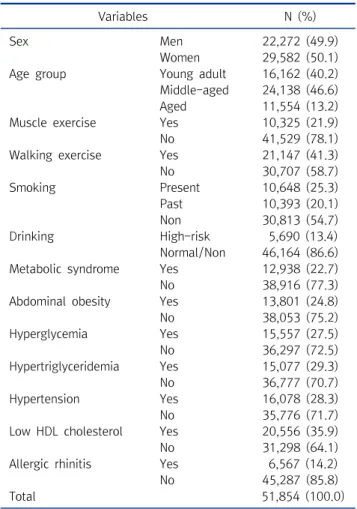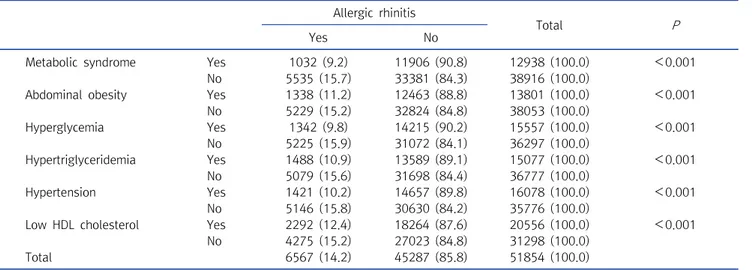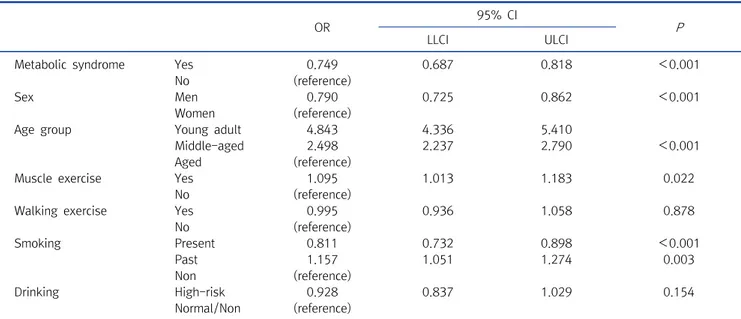* Corresponding author: Ji-Sook Lee
Department of Clinical Laboratory Science, Wonkwang Health Science University, 501 Iksan-daero, Iksan 54538, Korea
E-mail: jslee1216@wu.ac.kr
* ORCID: https://orcid.org/0000-0001-5397-9142
†Theseauthors contributed equally to this work.
ORIGINAL ARTICLE
Correlation between Metabolic Syndrome and Allergic Rhinitis
Min A Kim 1,† , In Sik Kim 1,2,† , Ji-Sook Lee 3
1
Department of Biomedical Laboratory Science, School of Medicine, Eulji University, Daejeon, Korea
2
Department of Senior Healthcare, BK21 Plus Program, Graduate School, Eulji University, Daejeon, Korea
3
Department of Clinical Laboratory Science, Wonkwang Health Science University, Iksan, Korea
대사증후군과 알레르기 비염의 상관관계
김민아 1,† , 김인식 1,2,† , 이지숙 3
1
을지대학교 대전캠퍼스 임상병리학과,
2을지대학교 대전캠퍼스 BK21 플러스 프로그램 시니어 헬스케어학과,
3원광보건대학교 임상병리과
ARTICLE INFO ABSTRACT
Received
April 15, 2019 Revised 1st May 13, 2019 Revised 2nd May 23, 2019 Revised 3rd June 5, 2019Accepted
June 5, 2019Metabolic syndrome and allergic rhinitis are two important chronic diseases that affect people all over the world. Metabolic syndrome very often induces other diseases and the prevalence of allergic rhinitis is currently increasing. Aging is known to affect the pathogenesis of various diseases such as metabolic syndrome and allergy. This study examined the effects of metabolic syndrome and the prevalence of allergic rhinitis depending on different age groups and several general characteristics. This study was conducted by using the data from the Korea National Health and Nutrition Examination Survey from the 4th, 5th, 6th, and 7th-1 (2007∼2016). The data used for this study was obtained from 51,854 people. In all age groups, our studies have shown that people without metabolic syndrome have a higher prevalence of allergic rhinitis than those people with metabolic syndrome, and the younger age group had the higher prevalence of allergic rhinitis ( P <0.05). Overall, the results of this study found a significant effect on the prevalence of allergic rhinitis in each category of age, general characteristics (physical activity, smoking and drinking) and the presence or absence of metabolic syndrome ( P <0.05). The evidence found in this study will help to understand the correlation between metabolic syndrome and allergy, and specifically allergic rhinitis.
Copyright © 2019 The Korean Society for Clinical Laboratory Science. All rights reserved.
Key words Age
Allergic rhinitis Metabolic disease Physical activity
INTRODUCTION
Metabolic syndrome is a condition in which chronic metabolic disorders cause hypertension, hypertri- glyceridemia, hyperglycemia, low HDL cholesterol, and abdominal obesity at the same time [1]. In the 2001 American cholesterol syndrome education program
(National Cholesterol Education Program Adult Treatment Panel III; NCEP-ATP III) defined metabolic syndrome as having more than three of the five components of waist circumference (male: >90 cm; female: >85 cm), hyper- glycemia (≥100 mg/dL), hypertriglyceridemia (≥150 mg/dL), hypertension (≥130/85 mmHg), and low HDL cholesterol (male<40 mg/dL, female<50 mg/dL) [2].
Although the cause of metabolic syndrome is not well known, it is generally assumed that insulin resistance is the root cause. It should also be noted that it is closely related to heart disease and diabetes [3]. However, this does not
Korean Society for Clinical Laboratory Science





